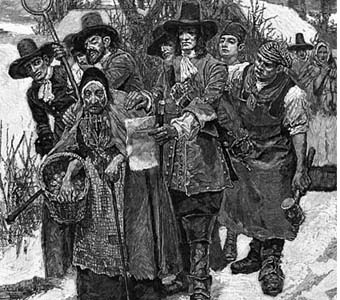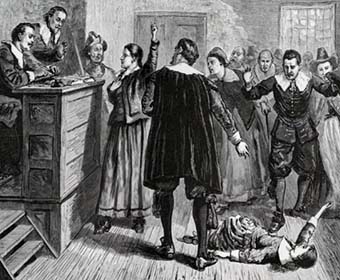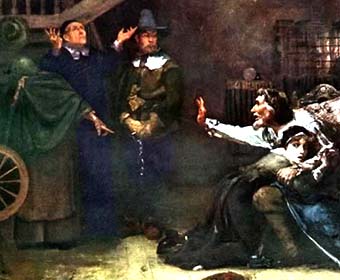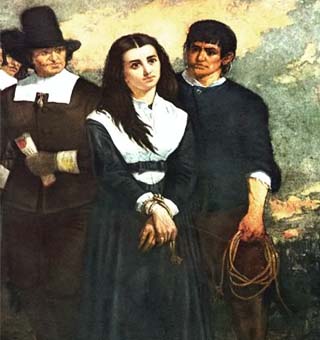|

A
woman is arrested for witchcraft in Salem. (Drawing by Howard
Pyle)
|
Part
II: The Witches of Salem: Theories and Speculations
In the year 1692 a number of young girls started
to show bizarre behaviors in the quiet village of Salem, Massachusetts.
They contorted and convulsed their bodies, crying out in an alarming
manner. Adults quickly concluded that the girls were bewitched
and hysteria swept through the small town. A court was convened
and 19 people, accused by these "afflicted" girls, were hung for
supposedly practicing witchcraft. Over a hundred other people
were arrested for the same crime and many spent months in jail.
A few died there.
What caused this sudden fear of witches and ripped
the small community apart? Nobody knows. The past three centuries,
however, have seen no end of books and articles filled with all
kinds of theories and speculation about the reasons behind the
terror. Today, scholars and pundits still look for meaning in
what happened. Here are some of the theories:
There
Really Were Witches at Salem
These days most people scoff at the idea that witches
exist, or if they do, that they have real supernatural powers.
It is important to remember, however, that in 1692 almost everybody,
from the most uneducated slave to the president of Harvard, believed
witchcraft was widely practiced and was a real threat to the community.
Cotton Mather, a respected Puritan minister who was present at
the time of the trials, wrote an account of them for the governor.
His essay clearly shows that he believed that some of the people
who were hung in Salem were indeed guilty of using black magic
to torment the "afflicted" girls. Though very much in the minority,
there are probably a few people even today who take the position
that this was indeed the case.
While many people in the period believed that witches
had supernatural powers given to them by the devil, many of the
better-educated people, such as philosopher Thomas Hobbes, acknowledged
that witchcraft was practiced but any spells that were cast only
had power in the minds of the witch and those that thought themselves
bewitched. It is important to note, however, that even Hobbes
thought that this kind of witchcraft, though it had no physical
power, brought real harm to a community and should be punished.
The
Afflicted Girls Thought They Were Being Bewitched
Here the argument is that in a society that believes
in witchcraft, witchcraft really works, not because there is any
supernatural power behind it, but simply because of how the fear
of being bewitched works on the victim's mind. Any symptoms such
as convulsive fits, blisters on the skin, or choking sensations
are psychosomatic rather than organic.
|

One
of the "afflicted" girls rolls on the ground as
a woman declares her innocence to the court.
|
Today we know that the mind can have a powerful
effect on the body. Placebos are a necessary part of many drug
studies in order that the psychological effects of taking the
medicine can be separated from the organic effects. Psychological
stress is known to cause all kinds of problems from rashes to
high-blood pressure and heart disease. Studies have shown that
hypnosis alone can induce an allergic reaction with no physical
agent involved.
If the girls believed that someone had cursed them,
that would have created enough stress in their minds to cause
physical symptoms. In fact, historian Chadwick Hansen argues that
many of the symptoms the girls had are nearly identical to a clinical
definition of hysteria.
Whether some of those accused of witchcraft actually
carried out some kind of ritual that might be associated with
cursing someone is not as important as if the girls believed that
this had been done. If the girls just believed that they had been
bewitched, it might have been enough to produce the physical effects
that were observed.
An
Out-of-Control Game
The "afflicted" girls who made the accusations
were some of the most powerless members of their society. Most
were young and unmarried, and some worked as menial servants for
other people. In the Puritan culture, nobody paid much attention
to them until they started acting strangely and having fits. Perhaps
it started as a game with the girls having no intentions of accusing
anyone of witchcraft or causing them harm. The concerned adults
around them seeking explanations soon came to believe the girls
were bewitched and started putting pressure on them to identify
the witch that was tormenting them. Perhaps the adults even suggested
a few candidates. Finally, when one of the girls gave in and named
a witch, they all saw what kind of power it gave them in the community
and how it would allow them to strike out at people they didn't
like.
Their fame wasn't only in the village but throughout
Massachusetts: a heady power trip for a young girl in Puritan
society. Once they started down this path, though, the girls found
themselves trapped. If they admitted that they had been lying,
they would be harshly punished for it, either by the authorities
or by the other girls.
At one point when it looked like someone was actually
going to be hung, one of the girls, Mary Warren, admitted she
had been making up the accusations and that the other girls had
been lying, too. Immediately, the rest of the girls turned on
her and identified Warren as a witch. Warren soon changed her
story again, saying she had been lying about lying. She had little
choice. If she had maintained that the girls had been making up
the stories about witches, she soon would have been tried as a
witch herself and probably hung. Many of the girls probably felt
like Warren that the game had gone too far but were unable to
confess to what they were doing for fear of what would happen
to them.
|

A
girl, terrified of being dragged off as a witch, seeks comfort
from a man, while her accuser and the village authorities
watch. From a painting by Douglas Volk.
|
There
was a Conspiracy Based on Village Politics
The village of Salem, even before the events of
1692, was considered one of New England's most divided communities.
Two extended families dominated the politics of the day: The Porters
and the Putnams. The issue that was on everyone's mind at the
time of the trials was whether the village of Salem should merge
with the town of Salem. The Porters favored this as they had close
connections with those in town and were already involved in town
politics. The Putnams did not, as they had exclusively focused
on village politics. The Putnams, while wealthy, were not as successful
as the Porters and were jealous. Perhaps they even blamed the
Porters and their friends for this.
One theory suggests that to get back at the Porters,
the Putnams had their girls accuse people in the community allied
with the Porters of being witches. There is some evidence for
this, as almost all the "afflicted" girls came from families connected
to the Putnams. The first two afflicted girls were Elizabeth Parris
and Abigail Williams, both members of Reverend Parris's household.
The Putnams were supporters of the Reverend Parris, the Porters
were against him. Ann Putnam, Jr, the daughter of Thomas Putnam,
was listed among the afflicted and apparently made many of the
accusations of witchcraft. Mercy Lewis, also an afflicted, worked
in his home. Mary Walcott, another accuser, was the step-daughter
of Deliverance Putnam, sister of Thomas.
The
"Afflicted" Girls Suffered from Some Physical Ailment
Some argue that the girls may have actually been
made sick by some unknown disease or poison that 17th century
medicine did not recognize. One of the causes most often mentioned
is ergot, a fungus found in rye grain. Ergot produces a poison
that affects the nervous and circulatory systems. Symptoms can
include convulsions, seizures and hallucinations.
Another possibility is that the girls contracted
encephalitis, a disease carried by mosquitoes. Encephalitis can
cause fever, headaches and confusion.
Critics of these explanations argue that it is unlikely
that only the girls in these households were affected by these
agents. However, if the agent was ergot, children and women seem
to be more susceptible to its poison and this may help explain
why only the girls seemed to be affected.
A Combination
of the Above Causes
|

A
woman is lead away to be hanged as a witch.
|
Perhaps the most likely explaination of what happened
is that it was a combination of many of the above possible causes.
It may be the case that the first victim, Beth Parris, may have
actually been sick with some unknown disease. It isn't hard to
imagine that the other girls, seeking the same attention she got,
joined in faking similar symtoms so they could share the limelight.
Adults, unable to find a satisfactory explaination in the natural
world, thought witchcraft was involved. The children were undoubtably
questioned about this. We know from recent studies that children
will try to please adults by giving them the type of answers they
seem to be seeking, especially if the the children are asked leading
questions or questioned repetitively. The adults would likely
ask the girls if the people tormenting them with witchcaft were
the people the adults considered in the community to be most-
likely allied with the devil: outcasts or political rivals. Some
of the girls, under this heavy questioning, might actually have
come to believe they were bewitched, while others knowingly lied
to please the adults and found themselves trapped in their own
lies.
We may never know for sure what were the exact causes
of the events in Salem Village in 1692. Sadly, these witchhunts
will probably be repeated in modern guise. One needs only to look
at the McCarty hearings of the 1950's and the satanic ritual abuse
trials of the 1980's to know that witchhunts are far from a thing
of the distant past.
Return
to Part I
A Partial Bibliography
The Salem Witch Trials, Edited by Laura Marvel, Greenhaven Press,
2003.
A Delusion of Satan, by Frances Hill, Da Capo Press, 2002.
The Devil in Massachusetts, by Marion L. Starkey, Doubleday,
1989.

Copyright
Lee Krystek 2006. All Rights Reserved.